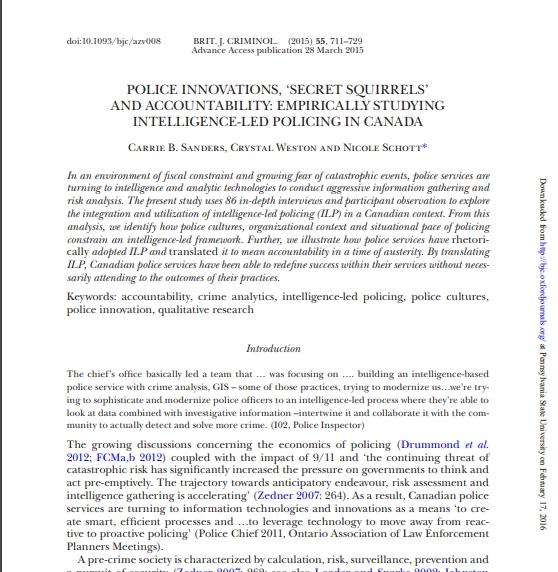POLICE INNOVATIONS, ‘SECRET SQUIRRELS’AND ACCOUNTABILITY: EMPIRICALLY STUDYINGINTELLIGENCE-LED POLICING IN CANADA by Carrie B. Sanders, Crystal Weston and Nicole Schott

| Title | POLICE INNOVATIONS, ‘SECRET SQUIRRELS’AND ACCOUNTABILITY: EMPIRICALLY STUDYINGINTELLIGENCE-LED POLICING IN CANADA by Carrie B. Sanders, Crystal Weston and Nicole Schott |
| Authors | NiCarrie B. Sanders, Crystal Weston and Nicole Schott About Authors |
| Overview | The article “Police Innovations, ‘Secret Squirrels’ and Accountability: Empirically Studying Intelligence-Led Policing in Canada” by Carrie B. Sanders, Crystal Weston, and Nicole Schott explores the growing reliance on intelligence-led policing (ILP) within Canadian law enforcement. ILP emphasizes the use of advanced technologies and intelligence gathering to drive proactive policing decisions, moving away from traditional reactive models. The study conducted by the authors investigates how Canadian police services are integrating ILP through the use of crime analytics, geographical information systems (GIS), and mobile data terminals (MDTs) to collect and analyze data to predict crime patterns and allocate resources more effectively. Using a combination of 86 in-depth interviews with crime analysts, patrol officers, and personnel from police information technology departments, as well as participant observation, the authors highlight several key themes. One prominent theme is the challenge posed by existing police culture, organizational structures, and the fast-paced nature of policing. These factors often hinder the effective adoption and utilization of ILP strategies. Although police departments rhetorically endorse ILP as a means of modernizing and increasing accountability in times of financial constraint, the actual implementation remains inconsistent. The authors argue that the adoption of ILP has become more of a symbolic gesture to demonstrate accountability and efficiency rather than a substantive shift in policing practices. A central focus of the article is the concept of “scientification” of policing, where crime analysis and intelligence technologies are believed to make policing more objective and data-driven. This belief is rooted in the idea that linking various data sources and spatially organizing information will lead to more informed decision-making and crime prevention. However, the study raises questions about the efficacy of these technologies, as there is little empirical evidence to support the notion that they enhance policing outcomes. The authors approach the study from a social constructionist perspective, which examines how police personnel interpret and enact ILP within their specific organizational and social contexts. They suggest that the adoption of ILP is shaped by broader cultural, political, and economic pressures, including a shift towards risk management and surveillance in a post-9/11 security landscape. Despite the theoretical promise of ILP to revolutionize policing, the study finds that in practice, it has been repurposed as a tool for maintaining public trust and demonstrating accountability, rather than significantly transforming how police work is conducted. Overall, the article provides a critical analysis of the integration of ILP in Canadian policing, offering insights into the cultural, organizational, and practical barriers to its full adoption. The study emphasizes the need for further empirical research to evaluate the real-world impact of intelligence-led frameworks on crime prevention and police accountability. |
| Download Link | click here to download |